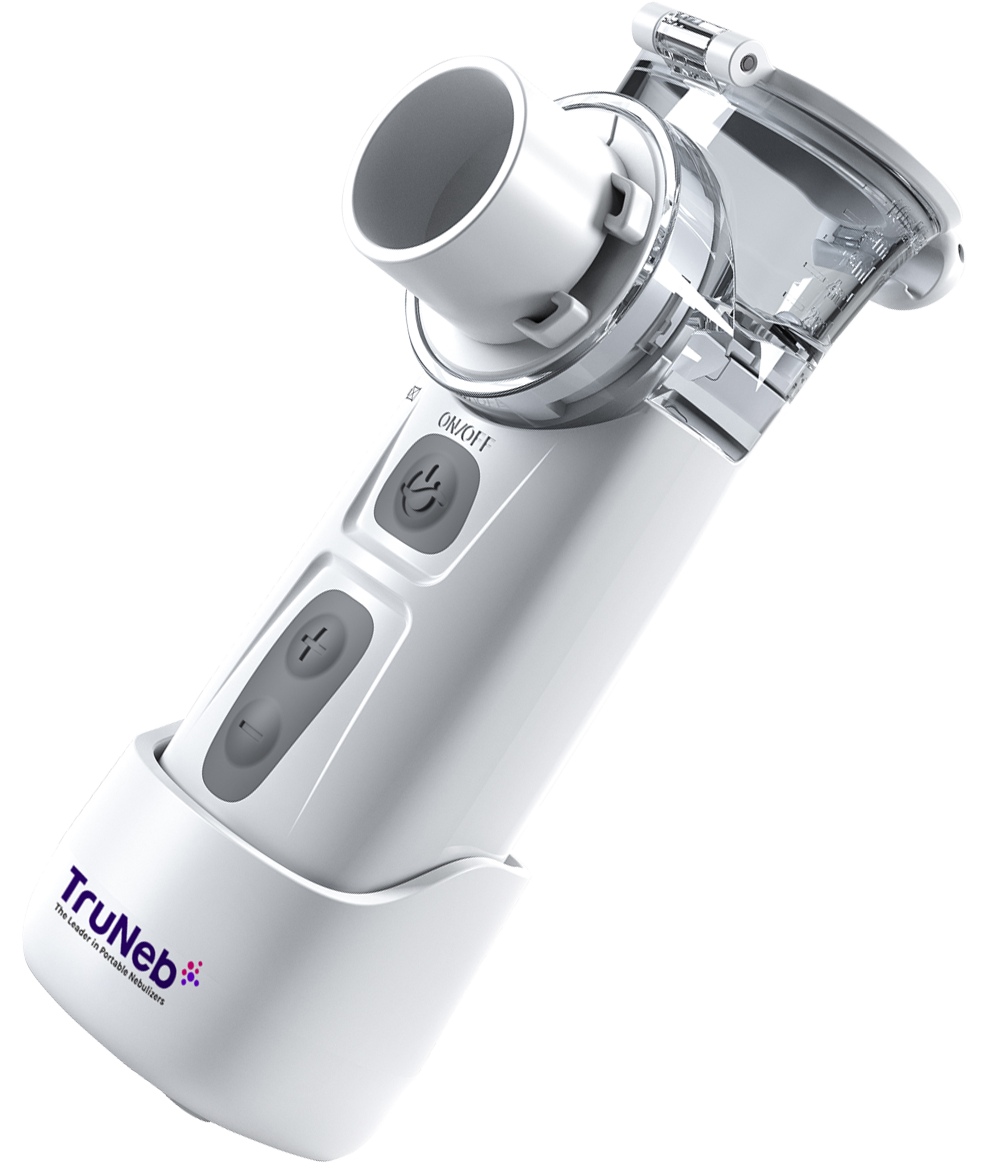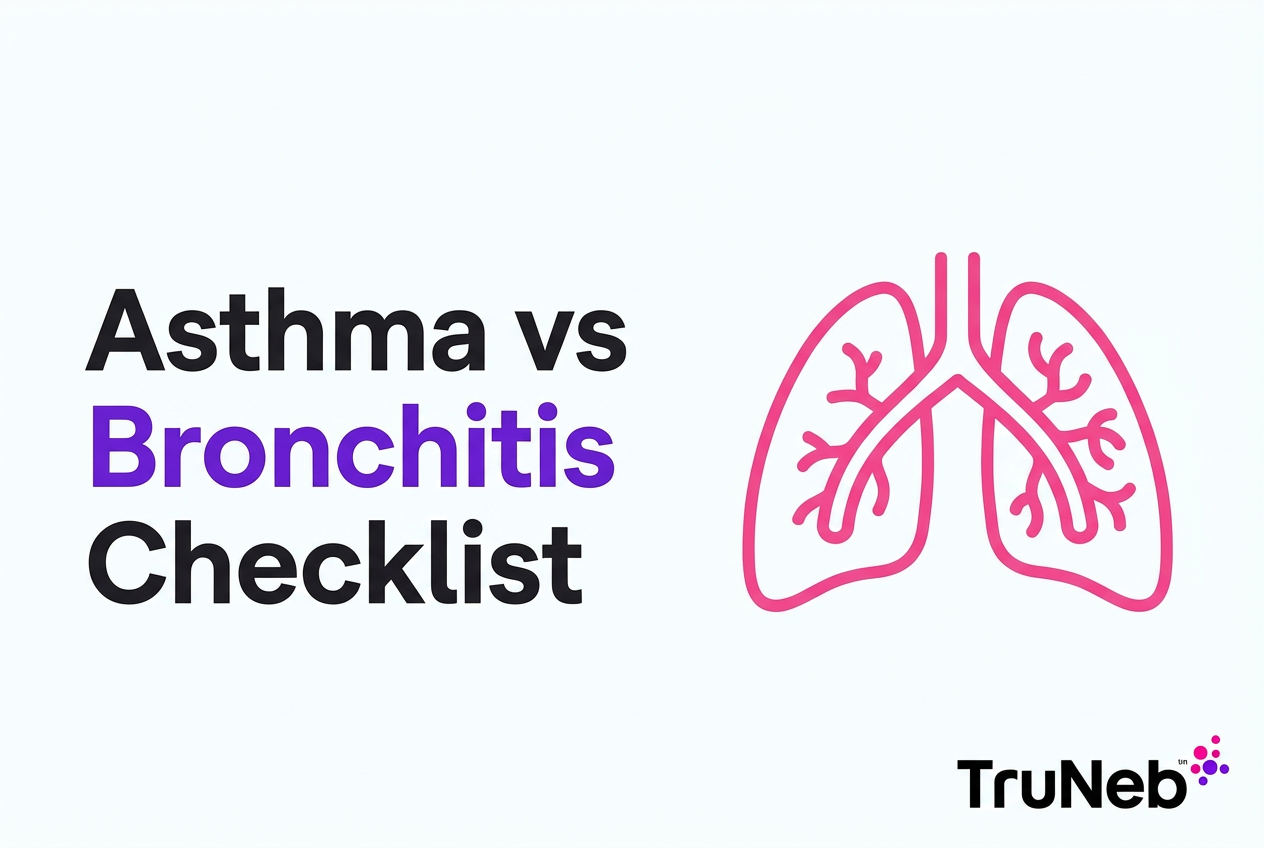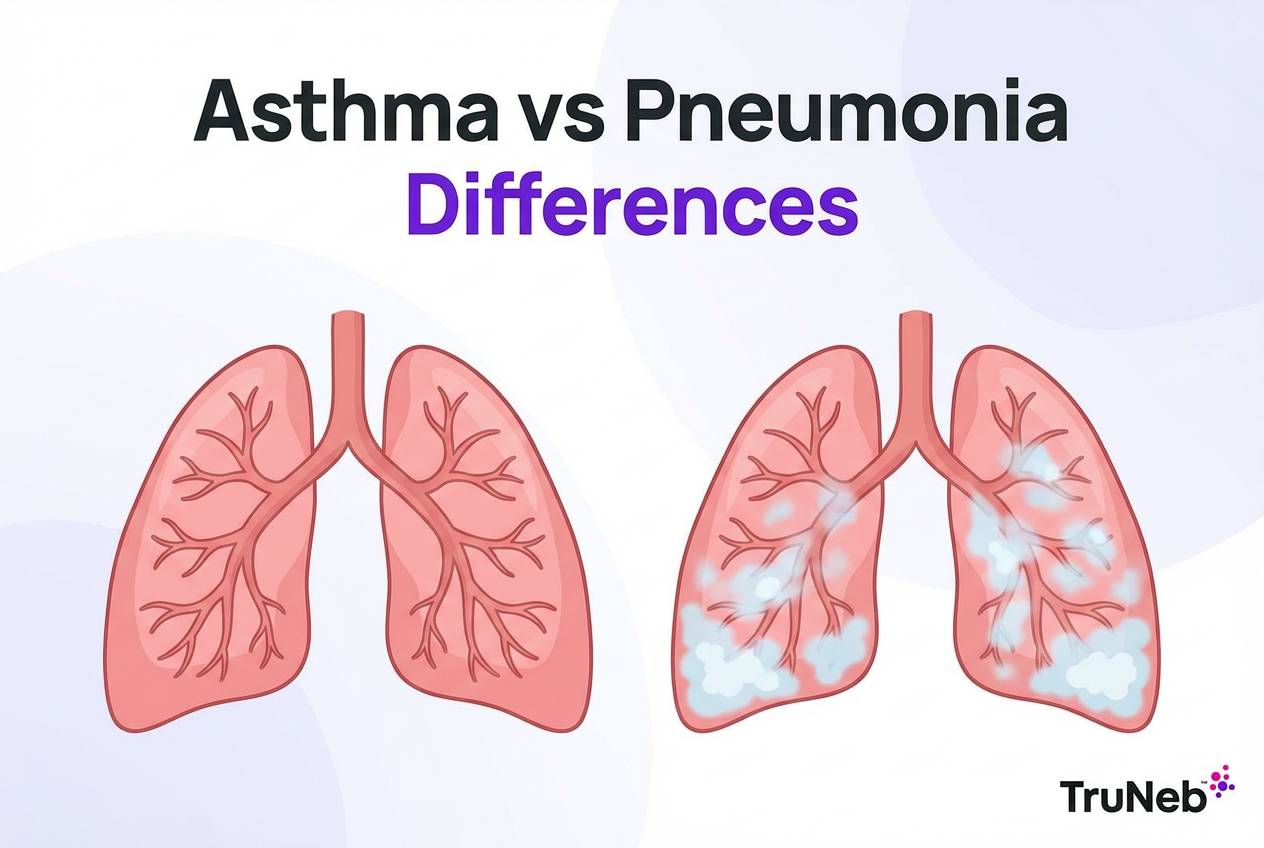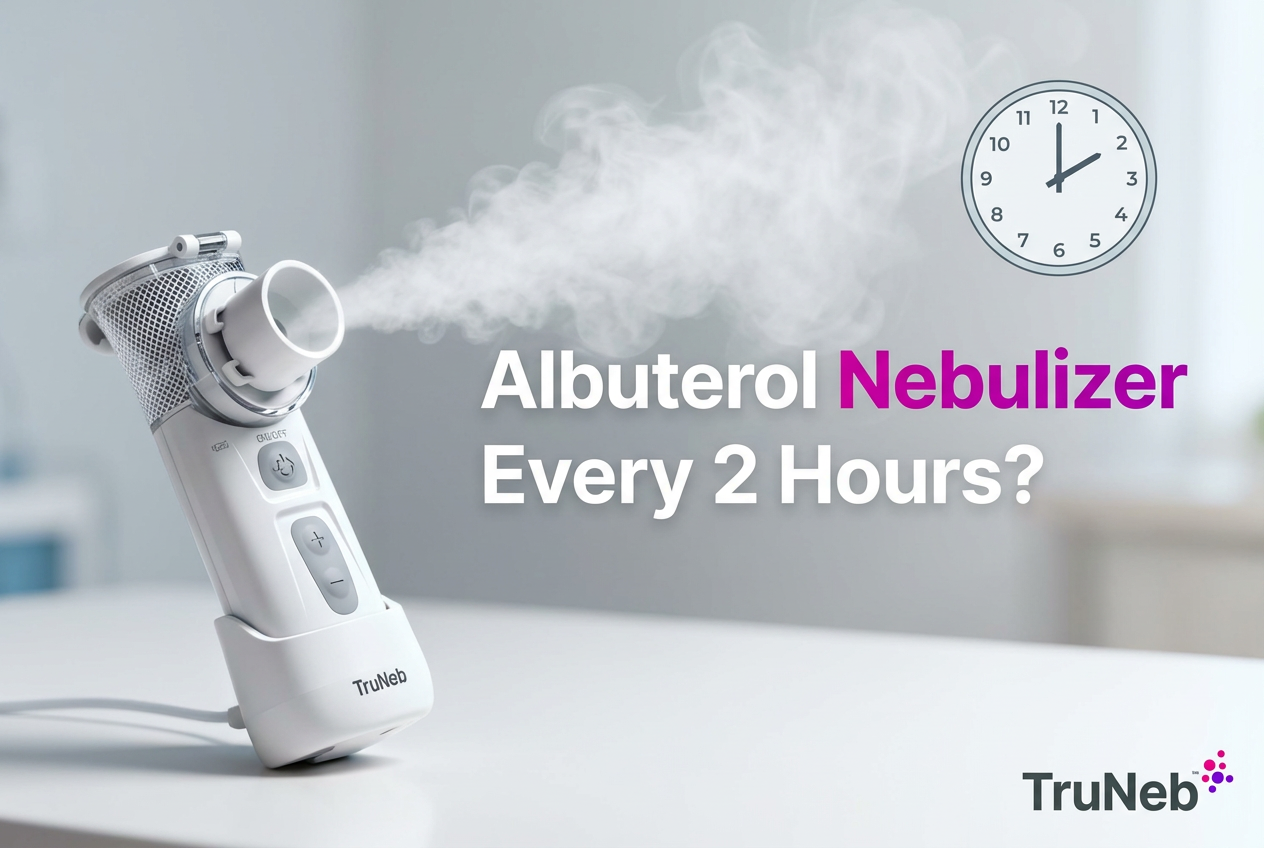On this page
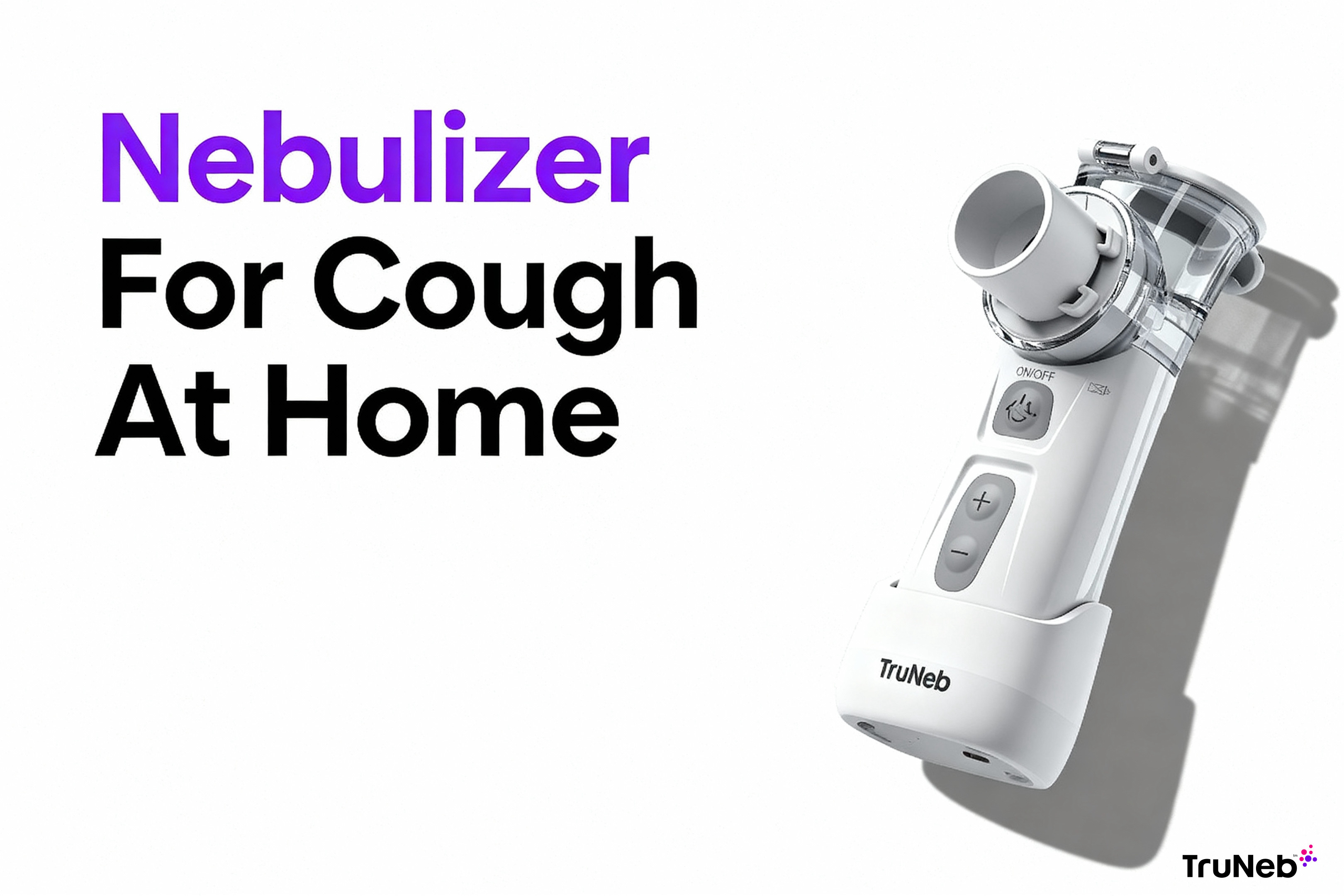
Why use a nebulizer for a cough?
A nebulizer turns liquid medicine or sterile saline into a fine mist you can breathe in. That mist goes straight to your airways and can help calm a cough, loosen mucus, and ease chest tightness. Doctors commonly recommend nebulizer treatments for coughs linked to asthma, COPD, bronchitis, or a bad respiratory infection.
A portable mesh nebulizer like TruNeb™ can make home treatments simpler because it’s small and quiet.
A nebulizer turns liquid medicine into a mist that reaches your lungs to soothe cough, loosen mucus, and ease chest tightness.

When should you use a nebulizer for a cough?
Use it when a doctor has diagnosed a lung issue that responds to inhaled therapy. Common times include:
- During an asthma flare with cough and wheeze.
- A COPD flare after a cold when cough and mucus get worse.
- A chest infection or bronchiolitis where thick mucus needs help moving.
⚠️ If your breathing is getting harder, you’re wheezing more, or your lips/face look blue, get emergency care right away.
Cough is a symptom, not a diagnosis. A doctor can help find the cause and decide if nebulizer treatments fit your plan.
Use a nebulizer for coughs tied to diagnosed lung conditions like asthma or COPD, as part of a doctor’s plan.
What you need at home
- Nebulizer device: a plug-in compressor or a portable mesh unit (for example, a TruNeb portable mesh nebulizer).
- Nebulizer cup/chamber for the liquid.
- Mouthpiece or face mask.
- (For compressor models) Tubing to connect cup to machine.
- Your prescribed medication or sterile saline.
- A clean, well-lit spot to sit upright.
- Steam inhalers are not nebulizers and aren’t for breathing medications.
Tip: Set up in a quiet place so you can breathe slowly and finish the full dose.
At home, you need a nebulizer device, a medicine cup, a mask or mouthpiece, and the prescribed solution.
Get ready for your treatment
- Wash your hands with soap and water.
- Add the prescribed solution to the nebulizer cup.
- Assemble the cup tightly. For compressor units, attach tubing to the cup and machine. For portable mesh units, insert the cup per the manual.
- Attach the mouthpiece or mask. Make sure a child’s mask fits snugly.
- Sit up straight in a comfortable chair. Keep the nebulizer upright. Make sure the device has power and the tubing isn’t kinked.
Wash your hands, add the prescribed solution, assemble the device, and sit upright before you start.
How to use a nebulizer for cough relief at home
- Turn on the nebulizer. Look for a steady, fine mist from the mouthpiece or mask.
- Seal your lips around the mouthpiece, or place the mask over nose and mouth.
- Breathe in slowly and deeply through your mouth. If comfortable, hold your breath for 1–2 seconds after a deep inhale, then exhale normally.
- If you start coughing, pause for a few normal breaths, then continue.
- Continue until the medicine is gone and the mist stops (about 5–10 minutes). A sputter sound usually means you’re almost done.
- Gently tap the cup if drops cling to the sides to use the full dose.
- Turn off the machine and remove the mouthpiece or mask.
Finish the full dose for best results.
Breathe the mist in slowly through a mouthpiece or mask until the cup is empty—usually 5–10 minutes.
Clean up right after you’re done
- Detach the cup and mouthpiece/mask. Rinse them under warm running water.
- Wash daily with mild dish soap and warm water if medication was used; rinse well.
- Disinfect weekly if your model allows (for example, soak parts in 1:3 white vinegar to water for 20 minutes), then rinse.
- Shake off water and air-dry parts on a clean towel. Make sure everything is fully dry before storing to avoid mold.
- Wipe the outside of the compressor. Keep it off the floor and check/replace air filters as directed.
- Don’t wash tubing; replace it as needed.
Rinse, wash, and fully air-dry parts after each use to prevent germs and mold.
Maintenance quick hits
- Replace the cup and mask/mouthpiece every 3–6 months or if cracked/cloudy.
- Check filters (compressors) and swap per the manual.
- Store parts dry in a clean case.
- Follow your model’s guide; mesh heads can be delicate.
| Option | Best for cough | What it does | Notes |
|---|---|---|---|
| Normal saline 0.9% | Dry/irritated cough; mild mucus | Adds moisture; may loosen light mucus | OTC sterile ampoules; generally well tolerated |
| Hypertonic saline 3% or 7% | Cough with thick phlegm | Draws water into airways to thin sticky mucus | May trigger coughing as mucus loosens; use under clinician guidance (3% often for kids; 7% for adults) |
| Bronchodilator* (e.g., albuterol, levalbuterol) | Asthma/COPD cough from bronchospasm | Relaxes airway muscles to reduce wheeze and cough | Possible jitteriness or faster heartbeat |
| Inhaled corticosteroid* (e.g., budesonide) | Persistent inflammatory cough (e.g., asthma) | Lowers airway inflammation over time | Maintenance therapy; not for instant relief |
| Anticholinergic* (e.g., ipratropium) | COPD-related cough | Reduces bronchoconstriction and secretions | Often used with bronchodilators |
* Prescription-only. Never nebulize cough syrups or essential oils.
What to put in the nebulizer for a cough
Common options include sterile saline 0.9%, hypertonic saline 3% or 7%, bronchodilators (albuterol, levalbuterol), and inhaled steroids (budesonide). Always use solutions made for nebulizers and follow your prescription.
Using a nebulizer for dry cough? Sterile saline 0.9% can help moisturize the airways. If you need a nebulizer for cough with phlegm, hypertonic saline can thin sticky mucus.
Use sterile saline or prescribed medications only—never cough syrups or essential oils.
Using a nebulizer for kids
- Talk with your pediatrician first. Use child-specific doses.
- Use a face mask for infants and toddlers. Hold your child upright in your lap.
- Keep it calm: a short show, song, or story helps steady breathing.
- If crying or upset, pause briefly and try again.
Kids usually tolerate sessions better at the same time each day, like before a bedtime story.
Children use a snug mask and calm, upright positioning; follow pediatric dosing from their doctor.
How often should you use a nebulizer for a cough?
Follow your prescription; treatments are typically spaced several hours apart. If you think you need them more often to control your cough, call your doctor. That’s a sign your plan may need an adjustment.
Follow your prescription; if you need treatments more often to control cough, call your doctor.
When to call the doctor
Seek help if:
- You have trouble breathing or fast breathing after a treatment.
- ⚠️ Lips or face turn bluish — call emergency services.
- Fever is high, chest pain occurs, or you cough up blood.
- Your cough lasts more than 2–3 weeks without improvement.
A nebulizer treats symptoms. You still need a plan that addresses the cause of your cough.
Get urgent care for trouble breathing, blue lips, chest pain, or a cough that isn’t improving.
Frequently Asked Questions
Tap or click a question below to see the answer:
Not every cough needs it. Nebulizers are usually for coughs tied to lung conditions like asthma, COPD, or severe bronchitis, as advised by a doctor.
Follow your prescription. Treatments are typically spaced several hours apart (often every 4–6 hours during flares). If you feel you need them more often, call your doctor.
About 5–10 minutes, or until the mist stops.
You can buy devices, but most medications for nebulizers require a prescription.
Nebulizers give a steady mist over minutes. Inhalers deliver quick puffs in one or two breaths. Doctors may use both in a plan.
No. Steam inhalers heat water to make steam; nebulizers deliver a medicated mist. Don’t put medicines in steam inhalers.
No. Only use sterile saline or prescribed medications made for nebulizers.
Disclaimer: This article is for informational purposes only and isn’t a substitute for professional medical advice. Always talk with your doctor about your symptoms, treatments, and medications.

